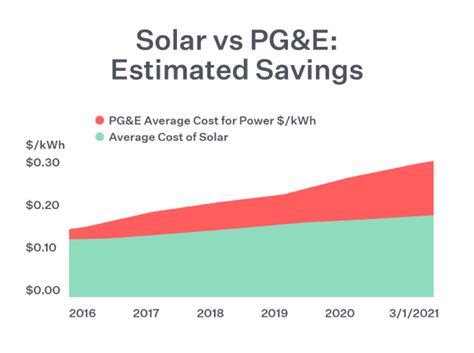Introduction
As energy costs continue to rise, many homeowners are exploring alternative sources of energy, particularly solar power. In California, Pacific Gas and Electric Company (PG&E) offers various programs, including solar rebates, to encourage residents to invest in renewable energy. This article will delve into the PG&E solar rebate program, outlining its benefits, eligibility, application process, and how to maximize your savings.
Understanding PG&E Solar Rebates
The PG&E solar rebate program is designed to incentivize California residents to adopt solar energy technologies. It provides financial rebates that can significantly reduce the upfront costs associated with solar panel installations. The aim is to make solar energy more accessible to a broader demographic, promoting a cleaner environment and energy independence.
Types of Rebate Programs
1. Solar Photovoltaic (PV) Rebate Program
This program is primarily focused on residential solar photovoltaic systems. Homeowners can receive a rebate based on the size of their solar energy system, specifically measured in watts. The rebate amount varies depending on the system’s capacity, and as of the latest updates, the program is available until a certain funding cap is reached.
2. Solar Incentive Program (SIP)
The SIP provides incentives for homeowners who invest in solar systems that meet certain efficiency standards. This program is part of California’s broader environmental goals and contributes to reducing greenhouse gas emissions. The SIP values the environmental benefits provided by solar energy and supports homeowners who make energy-efficient choices.
Eligibility Criteria
Before applying for PG&E solar rebates, homeowners should assess their eligibility. Common requirements include:
- The home must be located in PG&E’s service area.
- The solar system must be installed by a licensed contractor.
- The system must meet local building codes and safety regulations.
- Homeowners must apply for the rebate within a specified timeframe after installation.
The Application Process
Applying for PG&E solar rebates involves several steps:
- Choose a Qualified Installer: Select a licensed solar contractor who is familiar with PG&E’s rebate application process.
- Install the System: Your designated contractor will handle the installation, ensuring it meets all necessary codes and standards.
- Submit the Rebate Application: Once the system is installed, your contractor will help you complete the rebate application. This typically includes the system’s details, installation date, and proof of permit approval.
- Receive Your Rebate: After PG&E processes your application, you’ll receive your rebate check, reducing your overall solar investment.
Maximizing Your Savings
Maximizing savings from PG&E solar rebates requires careful planning:
1. Research and Compare Quotes
Take time to research multiple solar installers and obtain several quotes. Different companies can offer varying rates, equipment choices, and installation techniques. Comparing these can help you secure the best possible deal.
2. Consider Financing Options
Many financing options are available for solar installations, including loans, leases, and power purchase agreements (PPAs). Explore these options to find a financing solution that complements your financial situation while maximizing rebate benefits.
3. Evaluate System Size
Your system’s size will directly influence your rebate. A larger system may yield a higher rebate; however, it’s essential to balance size with your actual energy needs to avoid unnecessary costs.
4. Stay Informed on Policy Changes
Energy policies and rebate programs often change. Staying informed about updates from PG&E can help you time your installation for the best possible incentive.
Conclusion
Investing in solar energy is an excellent way to reduce your carbon footprint and save on energy bills. PG&E’s solar rebate programs present an opportunity for California homeowners to lower the cost of their solar installations significantly. By understanding the different types of rebates, eligibility criteria, and application processes, homeowners can effectively maximize their savings. With the right planning and information, switching to solar energy can be a financially beneficial move in today’s energy landscape.
Frequently Asked Questions (FAQs)
1. How much can I save with PG&E solar rebates?
The amount you can save depends on the size of your solar system, the capacity in watts, and the specific rebate program’s guidelines. Generally, homeowners can expect a rebate that helps cover a significant portion of their installation costs.
2. Are there any additional incentives for solar installation?
Yes, aside from PG&E solar rebates, California offers a statewide solar tax credit and various local incentives. These can further reduce installation costs and enhance your return on investment.
3. How long does the application process take?
The processing time for rebates can vary but typically takes a few weeks once all necessary documentation is submitted. It’s advisable to monitor your application status through PG&E’s customer portal for updates.
4. Do solar rebates affect my property taxes?
In California, the property tax reassessment law exempts solar energy systems from increases in property tax assessments. This means installing solar panels should not increase your property tax burden.
5. Can I combine PG&E rebates with federal incentives?
Yes, homeowners can combine PG&E solar rebates with the federal Investment Tax Credit (ITC) for added financial benefits. This can maximize your overall savings when investing in solar energy.
This HTML-format article provides a comprehensive overview of PG&E solar rebates, covering the necessary information for homeowners interested in maximizing their savings through solar energy investment.
Download Pg And E Solar Rebates
